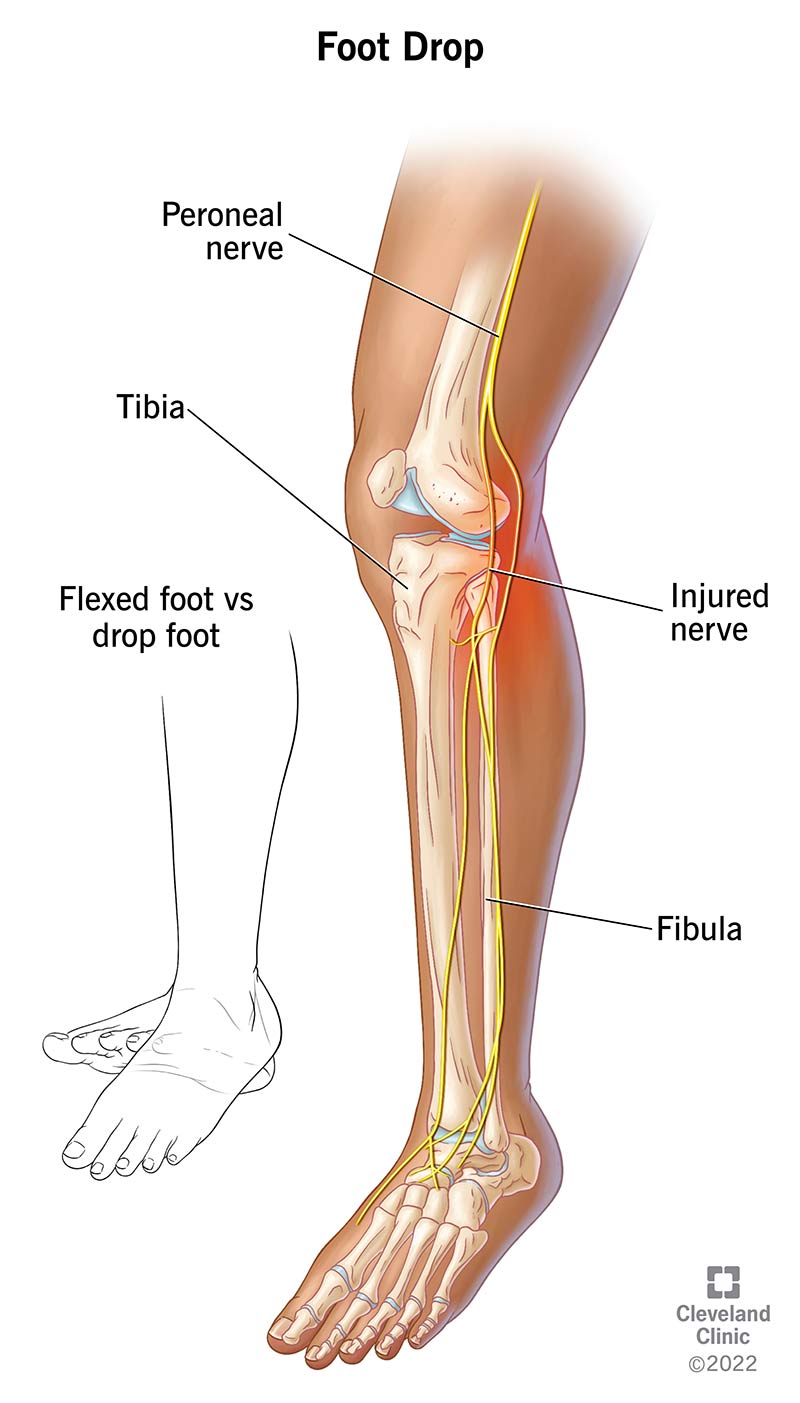Foot drop is a symptom in which you drag your toes when you walk due to weakness or paralysis of certain muscles in your foot. It has several possible causes. The most common causes are peroneal nerve injury and lumbar radiculopathy. It’s treatable in most, but not all, cases.
Advertisement
Cleveland Clinic is a non-profit academic medical center. Advertising on our site helps support our mission. We do not endorse non-Cleveland Clinic products or services. Policy

Foot drop (also called drop foot) happens when you can’t raise the front part of your foot due to weakness or paralysis of the muscles that lift it. It’s a symptom of several possible underlying conditions and can be temporary or long-term (chronic).
Advertisement
Cleveland Clinic is a non-profit academic medical center. Advertising on our site helps support our mission. We do not endorse non-Cleveland Clinic products or services. Policy
Due to weakness or paralysis, people who have foot drop often drag their toes when they walk. They may also have to lift their knee higher than usual to avoid dragging their toes. Walking this way may increase your risk of tripping and falling.
Foot drop can affect one of your feet (unilateral) or both of them (bilateral).
Foot drop has several possible causes, typically due to an issue with your nerves and/or muscles. The most common causes are lumbar radiculopathy and peroneal nerve injury.
Other causes include:
Radiculopathy happens when one of your nerve roots (where your nerves join your spinal column) is compressed or irritated.
Lumbar radiculopathy refers to a pinched nerve in your low back. Nerves that start in this area of your back extend down to your legs and feet. Your lumbar spine consists of the five bones (vertebra) in your lower back, labeled L1 to L5.
L5 radiculopathy specifically is a common cause of foot drop.
Radiculopathy usually happens due to narrowing of the space where your nerve roots exit your spine. This can be from:
Advertisement
Your common peroneal nerve is a peripheral nerve that extends down your leg. It’s a branch of the sciatic nerve that travels from the back of your thigh along the outside of your knee to the front of your lower leg. It supplies movement and sensation to your lower legs, feet and toes.
Several things can damage your common peroneal nerve and cause foot drop. Often, peroneal nerve injuries develop because of a traumatic injury to your knee, leg or ankle. These injuries include:
Injuries to your sciatic nerve in your buttock or back of your thigh can also cause a foot drop.
Your risk of peroneal nerve damage increases if you:
Sometimes, a tumor or cyst in your peroneal nerve can cause a foot drop. Inflammatory conditions, such as rheumatoid arthritis or lupus, can also damage your peroneal nerve.
Your peroneal nerve is a peripheral nerve (nerves outside your brain and spinal cord). Any condition that affects peripheral nerves, such as Charcot-Marie-Tooth disease or acquired peripheral neuropathy, can affect your peroneal nerve and cause foot drop.
Brain conditions that can cause foot drop include:
Motor neuron disorders that can cause foot drop include:
Less commonly, muscle conditions, such as muscular dystrophy or myositis, can also lead to foot drop.
People who have any of these conditions usually have other muscular and/or neurological symptoms.
To diagnose foot drop, a healthcare provider will perform a physical exam, which may show:
The provider may order any of the following tests to find the underlying cause of foot drop:
Nerve conduction studies and electromyography are very useful in finding where the nerve problem is.
Advertisement
Foot drop treatment depends on what’s causing it. In some cases, treating the cause will also fix foot drop. If the cause is a chronic condition, like multiple sclerosis or ALS, foot drop may be permanent.
Possible treatments include:
In some cases, people need surgery to relieve pressure on their peroneal nerve or to try to repair it.
For chronic foot drop, your provider may suggest fusing your ankle or foot bones. Or you may have tendon surgery in which a surgeon transfers a tendon from your other leg to the muscle in your affected leg to help it pull your foot up.
If the cause of foot drop is temporary, such as nerve inflammation or minor nerve damage from compression, foot drop can go away on its own once your nerve heals. In other cases, it may go away with treatment. For people who have underlying chronic conditions, like a neurodegenerative condition, foot drop is usually permanent.
As foot drop has several possible causes, there’s no way to know for sure what’s causing your case and if it will fix itself. Because of this, it’s important to see a healthcare provider so you can get a proper diagnosis.
Advertisement
You’re at higher risk of tripping and falling if you have a foot drop. Some steps you can take to help avoid this include:
If you’re unable to lift your foot or feet like you used to, see a healthcare provider. They’ll need to find the underlying cause to form a treatment plan.
Not being able to control your foot like you used to can be alarming. The good news is that drop foot can be temporary, and many cases go away completely with treatment. See a healthcare provider if you notice weakness in your foot and/or have difficulty walking. They’ll order tests to figure out the cause, and together, you’ll decide on a treatment plan.
Advertisement
Are you recovering from an injury, surgery or illness? Cleveland Clinic’s physical therapy team will help you get back to what you love to do.

Last reviewed on 01/16/2023.
Learn more about the Health Library and our editorial process.